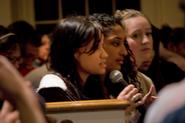
"I hate to use this word," explained a smiling Dan Chambliss, the Eugene M. Tobin Distinguished Professor of Sociology, "but it was a 'unique' event – it brought together students from about seven different courses."
The event in question was Bowling Night, in which about 200 students and faculty gathered in the Chapel on Dec. 2 to discuss a widely debated article by political scientist Robert D. Putnam. Putnam's 2007 article, titled "E Pluribus Unum: Diversity and Community in the Twenty-first Century," basically argues that Americans don't associate in groups as they used to, instead choosing to isolate themselves. As society becomes increasingly diverse, the people within that society deliberately detach from each other and trust declines. The article builds on the themes of Putnam's earlier book, Bowling Alone: The Collapse and Revival of American Community (2000), which gave the Chapel gathering its name.
Professor of Government Ted Eismeier organized the event, which was emceed by Chambliss. The participants were from a whole host of courses, ranging from introductory to advanced, giving the discussion an array of "several academic perspectives" from classes such as government, statistics, sociology, women's studies and disabilities studies. Four students formed a panel that offered a few minutes' worth of exposition and commentary. Afterward, discussion was open to the audience. Ultimately, about 25-30 people spoke up.
Some agreed with the article; others found flaws in its design and evidence. One student acknowledged that if a person lives in a population with high heterogeneity, that person may not trust those in different ethnic groups. However, she also said that Putnam's article fails to look at changes over time, and thus cannot compare today's levels of diversity and trust to any sort of "standard" or control.
Another student posited that Putnam uses only race and ethnicity to define social identity, but that those are just two of many influential factors. Also, the definition of "trust" varies from community to community.
At one point, Professor Chambliss asked the audience whether Hamilton is an example of Putnam's argument. One student said that Hamilton indeed accurately reflects the article because the college's demographics match the demographics Putnam utilized in his study: mostly economically privileged whites. Also, the student claimed that Hamilton is most supportive of diversity when it suits the college's needs (good publicity, for example). Some believed – and others disputed -- that there was a wider acceptance of diversity at Hamilton than in society in general.
Other issues discussed at length were the actual definition of social capital -- the benefits of social networks, mutual regard and cooperation provided by a group -- and the link between that capital and distrust. Some participants argued that Putnam's claims went far beyond his evidence.
What was most noticeable, however, was that students and faculty alike became increasingly passionate in their responses as the event drew to a close. Said Professor Chambliss: "That's what you want!"
-- by Alex Pure '12
The event in question was Bowling Night, in which about 200 students and faculty gathered in the Chapel on Dec. 2 to discuss a widely debated article by political scientist Robert D. Putnam. Putnam's 2007 article, titled "E Pluribus Unum: Diversity and Community in the Twenty-first Century," basically argues that Americans don't associate in groups as they used to, instead choosing to isolate themselves. As society becomes increasingly diverse, the people within that society deliberately detach from each other and trust declines. The article builds on the themes of Putnam's earlier book, Bowling Alone: The Collapse and Revival of American Community (2000), which gave the Chapel gathering its name.
Professor of Government Ted Eismeier organized the event, which was emceed by Chambliss. The participants were from a whole host of courses, ranging from introductory to advanced, giving the discussion an array of "several academic perspectives" from classes such as government, statistics, sociology, women's studies and disabilities studies. Four students formed a panel that offered a few minutes' worth of exposition and commentary. Afterward, discussion was open to the audience. Ultimately, about 25-30 people spoke up.
Some agreed with the article; others found flaws in its design and evidence. One student acknowledged that if a person lives in a population with high heterogeneity, that person may not trust those in different ethnic groups. However, she also said that Putnam's article fails to look at changes over time, and thus cannot compare today's levels of diversity and trust to any sort of "standard" or control.
Another student posited that Putnam uses only race and ethnicity to define social identity, but that those are just two of many influential factors. Also, the definition of "trust" varies from community to community.
At one point, Professor Chambliss asked the audience whether Hamilton is an example of Putnam's argument. One student said that Hamilton indeed accurately reflects the article because the college's demographics match the demographics Putnam utilized in his study: mostly economically privileged whites. Also, the student claimed that Hamilton is most supportive of diversity when it suits the college's needs (good publicity, for example). Some believed – and others disputed -- that there was a wider acceptance of diversity at Hamilton than in society in general.
Other issues discussed at length were the actual definition of social capital -- the benefits of social networks, mutual regard and cooperation provided by a group -- and the link between that capital and distrust. Some participants argued that Putnam's claims went far beyond his evidence.
What was most noticeable, however, was that students and faculty alike became increasingly passionate in their responses as the event drew to a close. Said Professor Chambliss: "That's what you want!"
-- by Alex Pure '12
Posted December 4, 2008
